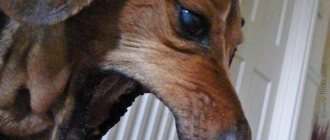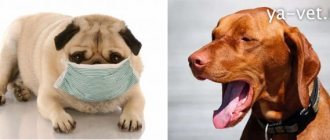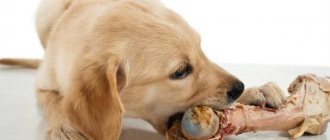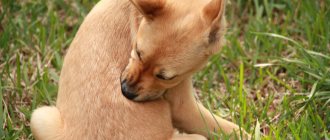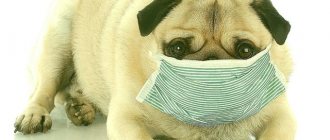If there is a dog in the family, many owners believe that it should be pampered with bones. Although later, if a dog has a bone stuck in its throat, they don’t know how to help it. Bones are believed to be very beneficial for dogs, although in reality they have little nutritional value and are dangerous to the dog's health.
Especially boiled bones must be excluded from the animal’s diet. This type of feeding provides absolutely no nutritional benefit to the dog. When a pet gnaws such a bone with its teeth, sharp small fragments are formed. If he swallows them, they can get caught in the gastrointestinal tract or the dog's mouth. Only then do the owners think about how to remove the bone from the dog’s throat in order to help their pet.
If the bones have been boiled, they split very easily during the gnawing process, forming sharp fragments that can injure the dog’s stomach, esophagus or intestines. But the most dangerous of them are fish bones. They can pierce internal organs and lead to disruption of the integrity of the intestinal walls, which can lead to surgery or death of the animal.
How does swallowing occur?
All animals can have difficulty swallowing. This is due to their desire to chew something or eat too large a piece.
Fine
Swallowing is a natural reflex to the entry of food into the oral cavity. Living things control the process of chewing, but not the swallowing itself. It occurs due to irritation of the receptors that are located at the root of the tongue. Then the formed lump moves into the esophagus uncontrollably, at the level of a reflex.
Normally, food bypasses the respiratory tract and slides down the esophagus into the stomach. The natural course of events can be disrupted by awkward chewing or sudden movements.
Entry of a foreign body into the respiratory tract
During swallowing, the soft palate rises, thereby closing the common cavity of the pharynx and nasal passages. This prevents food from entering the trachea and ensures its normal movement into the esophagus.
However, a pet's swallowing organs are designed so that they do not allow a piece that is too large or hard to pass through. The entry of a foreign body into the respiratory tract is explained by the dog’s excessive activity during lunch or games - when a small toy causes a swallowing reflex and ends up in the wrong place.
How a dog can choke: causes of suffocation
While eating, animals, unlike humans, do not talk. However, blocking the pharynx with a foreign body is still possible - often this occurs as a result of quickly eating dry food. Fish or chicken bones, pieces of wood, plastic and other materials from toys can cause danger.
There are a number of reasons leading to suffocation:
- Hasty eating
. Your pet should eat in a calm environment so that they can slowly chew and swallow food.
- Physical activity while eating
. It is typical for small, restless puppies.
- Games with foreign objects
. Small parts of toys, furniture, and clothing are dangerous for all animals. Large individuals are capable of swallowing small balls or toys whole.
- Consuming bones
. It is strictly forbidden to give chicken and fish bones to four-legged animals. Only whole beef or lamb bones are suitable as a treat - or special treats from the store.
The task of the owner of a pet friend is to closely monitor his games and feeding process. It is important to exclude dangerous foods and not allow furniture, clothing or shoes to be chewed. Small and sharp particles, even if successfully swallowed, lead to serious damage to the gastrointestinal tract.
Killer treat
Sugar bone is the number one dog delicacy. This deep-rooted misconception is persistently refuted by life. Even wolves, the predatory ancestors of man’s barking companions, leave behind “horns and legs” from the prey they eat.
What can we say about a domestic dog that is accustomed to industrial food or delicate “human” food? A bone can turn into a lethal weapon for her. Such a “delicacy” can injure the throat, lead to organ ruptures, lose teeth, and cause suffocation.
How to tell if a dog is choking
A reflex cough allows the pet to independently spit out a foreign body that has entered the throat. However, there are times when a pet cannot do without outside help. If an owner has never experienced choking in a pet, it may be difficult to recognize the signs.
Symptoms of lack of air include:
- uneven and heavy breathing;
- sharp cough;
- gagging;
- choking on saliva;
- restless behavior;
- bluish color of the inside of the mouth.
Respiratory spasm can last for varying lengths of time, from a few seconds to minutes. Large lumps can provoke the urge to vomit, which is aimed at pushing out a foreign body - this, most often, helps.
Sharp pieces injure the delicate insides, cause severe pain, and drops of blood may appear in the saliva. Prolonged asphyxia leads to loss of consciousness and death of the patient. Therefore, it is important to at least partially open the animal’s access to oxygen as soon as possible.
First aid
It is not always possible to urgently visit a veterinarian who will provide first aid to the victim and monitor his condition. Therefore, the owner should know what to do if the dog chokes - at least just in case.
Small or large dog
The main task of a person is to clear the airways from a foreign object. To do this, you need to grab the dog from the back and place your palm folded into a fist on the lower edge of the sternum. With your other hand you need to fix your elbow so that a ring is formed.
Now you should perform squeezing movements, moving forward and upward. On average, five presses are enough to clear the airways. This is the Heimlich maneuver and has been successfully practiced on humans and large to medium sized dogs.
If a small dog is choking, the principle of action is the same. You just need to take the dog on your lap and press it against your back. Cross your palms on the lower chest, fix your head if possible. Further movements are performed by analogy.
If the lump has penetrated the esophagus, you need to understand how far it has descended and whether it can be pulled out. It’s more convenient to do this together: one firmly holds the pet’s head motionless, the other opens its mouth and presses on the base of the pharynx. To do this, you can use a flat stick or a spoon handle. Sometimes they use tweezers, with which they grab the stuck piece by the edge and slowly pull it out.
Find out the nature of the foreign object
You can understand how to help a dog if it is choking and coughing after determining the nature of the foreign body. If dry food or hairballs enter the respiratory system, it causes sudden, severe coughing attacks.
To save your pet from misfortune, you need to lift it by its hind legs and shake it. You can induce gagging, which will allow you to spit out the lump. This can be done with a pinch of table salt sprinkled on the root of the tongue.
In the warm season, the animal chokes on seeds and other small parts of plants. So, a pet may choke on a burdock that sticks to its fur - it tries to pull out a thorn and accidentally swallows it. Brown bread and butter will help push the inflorescence down the esophagus. You can try the same with a stuck fish bone.
Precautionary measures
A dog frightened by the situation can, without meaning to, cause harm not only to itself, but also to a person. The four-legged friend begins to rush around the room, knocking down everything in his path. He is capable of injuring himself on the sharp corners of furniture or being scratched by shards of broken dishes. It is important for the owner to keep his frightened four-legged friend from possible problems. To do this, they try to stop the dog in one place, firmly fixing it.
To prevent an animal from biting a person who wants to help him, you need to press the dog’s head with your elbow. He shouldn't move his face. This will rid the pet of a foreign object and will not give the opportunity to bite the owner. It is better if two people can provide first aid to the victim at once - one will hold the patient tightly, and the other will remove the foreign object.
When performing the Heimlich maneuver, you need to be careful not to break the dog’s legs or ribs, especially a small one. Control the force of pressing and do not panic yourself.
Diagnostics, history taking
If only a single attack was noticed, then there is no need to panic. If you have a frequent cough, notice it early and start treatment. If an attack of suffocation begins, you need to provide first aid.
- The animal is small - turn it upside down and pat it on the back, shaking it slightly.
- If the pet is large, then bring it to a standing position. Lift him slightly by the legs and pat him on the chest.
- Be sure to ensure that the dog does not choke on his own tongue.
- To check if the airways are open, short-faced animals need to stick 2 fingers into the mouth. These breeds have a soft, long palate that physically blocks the airways.
- If breathing stops, resuscitation is necessary.
Once the attack is over, take the dog to the vet. He will determine the cause and, if necessary, prescribe medications.
When you need to urgently go to the veterinary clinic
If a pet has difficulty breathing, the owner’s natural desire is to help the suffering pet. Unfortunately, it is not always possible to cope with the problem on your own. In this case, it is important to contact a veterinary clinic as quickly as possible.
The doctor will provide qualified assistance to the patient, perform an x-ray or ultrasound, and in difficult cases, give anesthesia. Investigations are prescribed if it is impossible to detect a foreign object visually or by touching it with your hands.
Based on the results of the examination, a specialist may prescribe medications to reduce swelling and inflammation of the larynx or perform surgery. A quick visit to the doctor will save your pet's life. In this regard, you should not hesitate if your dog is choking and cannot clear his throat.
Life without risk factors
Seeing a four-legged pet wheeze and suffocate is unbearable. The simplest preventive measures will help prevent misfortune:
- exclusion of any bones from the pet’s diet;
- prohibition of vagrancy, which is fraught with the search for “prey” in the form of inedible and dangerous foreign bodies.
Remember, bones are a cheap product that can cost you a lot. Block his path to the dog bowl forever - and he will not know grief. Pamper your pet with safe chewable treats from the pet store.
If the cough is not caused by a foreign object
A cough in a four-legged friend is a nonspecific sign of various ailments. The owner does not always understand what causes this symptom. It is important to take a close look at the animal when it coughs. If it occurred while eating or playing with various objects, then most likely your four-legged friend choked.
The occurrence of a cough during rest or walking may be a symptom indicating problems with the dog’s health. Often the cause is lungworms, allergies, and upper respiratory tract diseases. Outwardly, it looks like the dog has something stuck in its throat, but upon closer inspection it turns out to be different.
